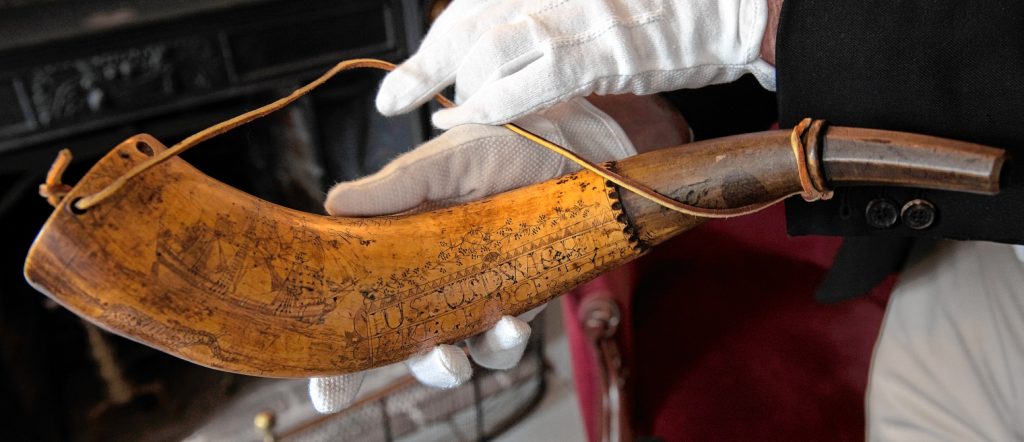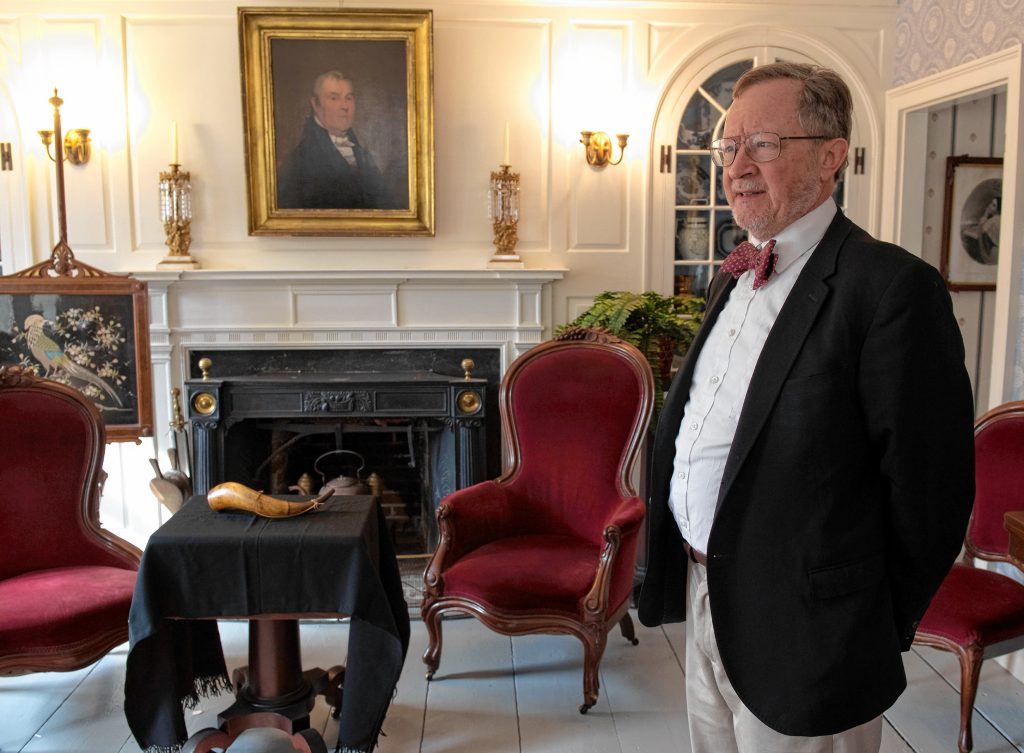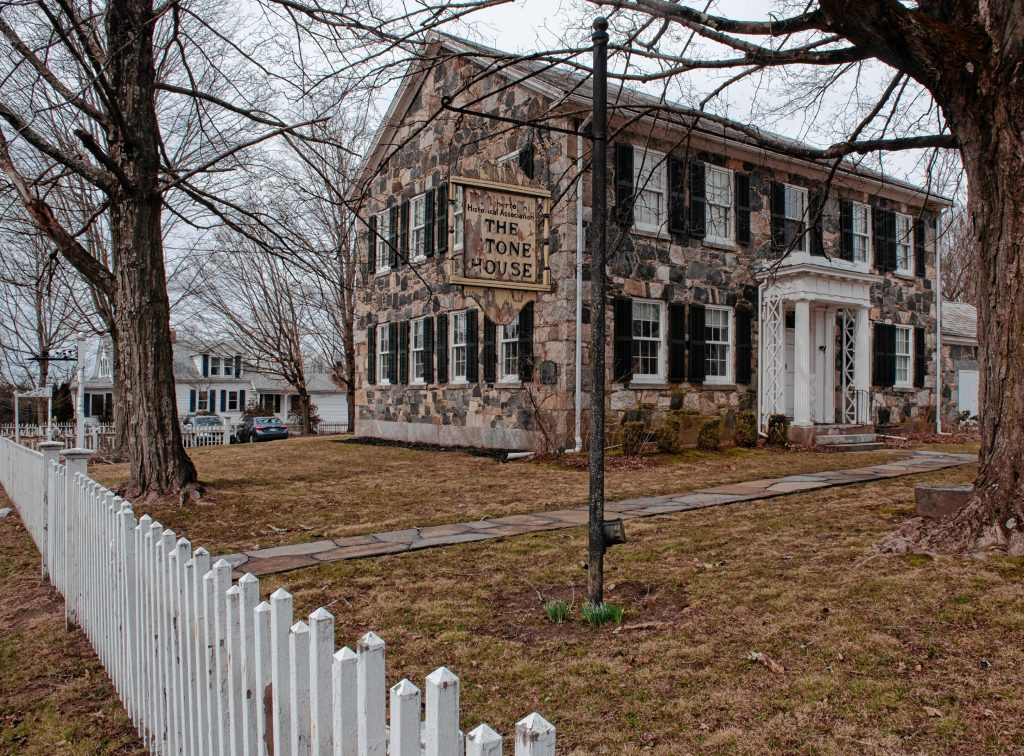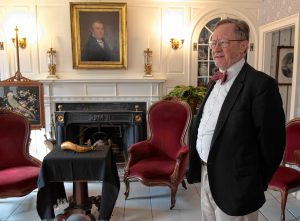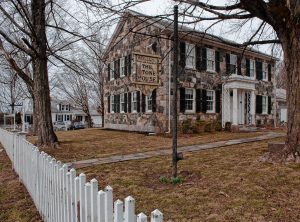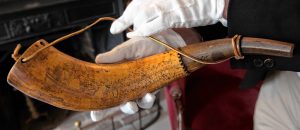
Tom Stockton, the president of the Belchertown Historically Association, holds a Powder Horn owned by Justus Dwight in the 1800’s. The artifact was stolen form the Stone House museum over 50 years ago and recently recovered.
By SCOTT MERZBACH
Staff Writer
BELCHERTOWN — In the summer of 1971, Michael Corbett, a visitor to the Stone House Museum, arriving with his girlfriend, signed the guestbook and toured the historic building at a time when it still housed three antique powder horns, including one used more than 200 years earlier by Belchertown resident Justus Dwight while he was an ensign in the French and Indian War.
That August, though, the famed powder horn that Dwight made, signed and inscribed, and which had been photographed in the 1960s for “The History of Weapons of the American Revolution” publication, was stolen from the Maple Street museum.
After more than 50 years missing, the 1758 powder horn recently was returned to its rightful home.
“This one is so important,” says Tom Stockton, president of the Belchertown Historical Association. “When we try to tell the story of Belchertown, to have an 18th-century artifact, something from so early in the town’s history, is thrilling.”The Stone House Museum is one of 16 museums, mostly in the Northeast but from as far south and west as Jackson, Mississippi, that had their antique firearms returned following the 2021 indictment of Corbett, a Newark, Delaware resident who pleaded guilty to possession of stolen items transported across state lines following a lengthy investigation that included a search of his home in 2017 in which many of the items were recovered.
As part of his plea agreement, Corbett turned over to the government additional stolen firearms to which he had access.
The powder horn, which Stockton said is “quite ornate,” was among 50 stolen artifacts, which also included an 1847 Mississippi rifle, a World War II battlefield pickup pistol that belonged to Gen. Omar Bradley and a 19th-century Pennsylvania rifle stolen from the Daniel Boone Homestead. The items were recovered through the efforts of the FBI Art Crime Team in Philadelphia, the U.S. attorneys’ office of the Eastern District of Pennsylvania, the Upper Merion Township Police Department, and the Montgomery County district attorney’s office.
Although Corbett was suspected of personally taking these historic items from museums, most of them 50 years ago, prosecutors were unable to bring theft charges owing to a lack of evidence.
Traveling to Philadelphia to take part in a repatriation ceremony March 13 at the Museum of the American Revolution — located on the third floor of Liberty Hall — Stockton was joined by representatives from other area museums in getting back items, including the Springfield Armory Museum and the Longmeadow Historical Society. While at the ceremony, he saw the wide array of guns that had been taken. There, Stockton thanked the museum for its repatriation, the district attorneys for pursuing the case, and authorities for bringing the federal grand jury indictment in the Eastern District of Pennsylvania.
Stockton said the work that went into finding the weapons was impressive. The cold case investigation was reopened in 2009 based on a confidential source who turned over several antique firearms believed to have been stolen from museums, including an 18th-century flintlock musket stolen from the Valley Forge Museum in 1970 and a 1775 musket stolen from a Schoharie, New York museum.
He also said he believed they were getting closer to cracking the case when he began receiving calls from a detective in King of Prussia, Pennsylvania, regarding Corbett. “He had never given up on this guy,” Stockton said.
Justus Dwight’s legacy
Justus Dwight is an important figure in Belchertown’s history. Following the French and Indian War, in which he served with his father, Capt. Nathanial Dwight, Justus Dwight was at the Massachusetts convention for ratifying the U.S. Constitution following the Constitutional Convention in 1787.
The museum holds the diaries that provide eyewitness accounts to the proceedings in Boston where Dwight was among those voting in the minority of the 187-168 vote on Feb. 6, 1788. The debate on ratifying the U.S. Constitution centered on the strength of a centralized government and whether a Bill of Rights should be adopted.
The powder horn, likely made from the horn of a steer, helped keep gunpowder dry before loading a musket. Dwight’s initial inscription read: “with powder and with ball, hero like to conquer all.” Later, he added, “and steal not this horn for fear of shame, for here you find the owner’s name, Justus Dwight.”
For a century, the historical association has housed in the 1827 home constructed with native fieldstone by Justus Dwight’s son, Jonathan Dwight, as a wedding gift for his daughter, Julia Diantha Dwight, said Sally Shattuck, an historical association trustee.
The property was donated to the historical association in 1922 by Harriette Dwight Longley, who was living in California at the time. The site has since grown to a campus that includes the Ford Annex, named after auto pioneer Henry Ford, who visited Belchertown several times when it was known for carriage construction. Other buildings on the site include the Washington District one-room schoolhouse, a project that is still in progress, and the original Belchertown Sentinel newspaper print shop.
For the public, the first opportunity to see the powder horn back in its rightful location will come when the museum opens for the season in May on the Saturday of Mother’s Day weekend. The opening will coincide with a plant sale, with shrubs, perennials and annuals, a craft fair, and an old bag sale with gently used clothing.
Stockton said he isn’t sure how exactly the historic object, with an estimated $5,000 value, will be displayed, but the powder horn will be protected and safeguarded and secured in ways that artifacts weren’t in 1971.
He anticipates that there will be a lot of excitement in town around the powder horn, as well as a recently restored “Uncle Sam Wants You” poster from World War I. That poster is one of just a handful that still exist. “This will attract business for us this summer,” Stockton said.
Though the other two powder horns from the Belchertown museum have not been returned, and it’s uncertain whether they were taken at the same time and in the same way, there is no evidence yet that Corbett was responsible for their thefts, as he didn’t turn them over under his plea agreement, in which he was sentenced to a single day in federal prison and three years of electronic monitoring.
But for the town’s most famous powder horn, there is only gratitude for its return.
“This is such a poignant homecoming for the powder horn to come back,” Stockton said.

